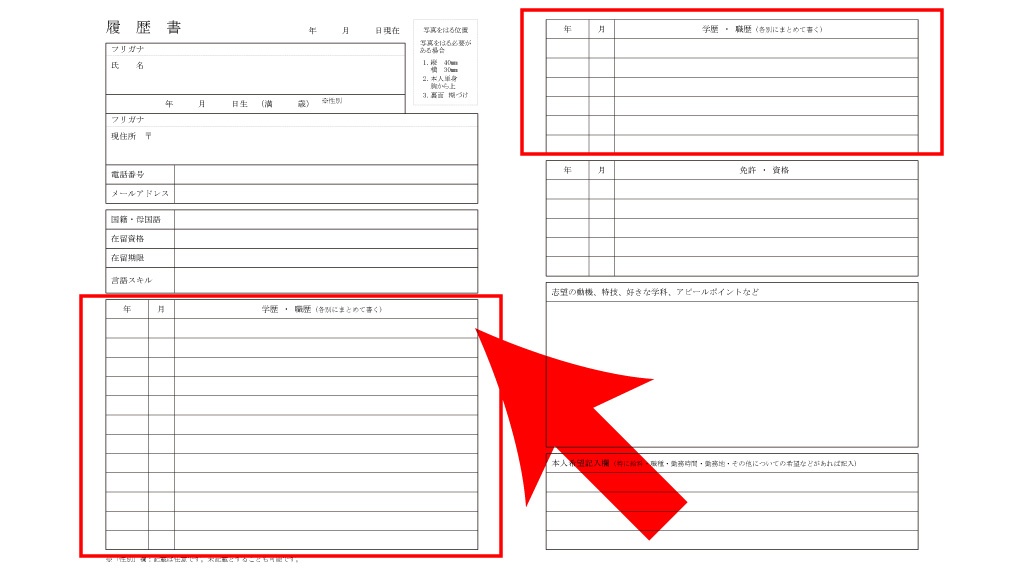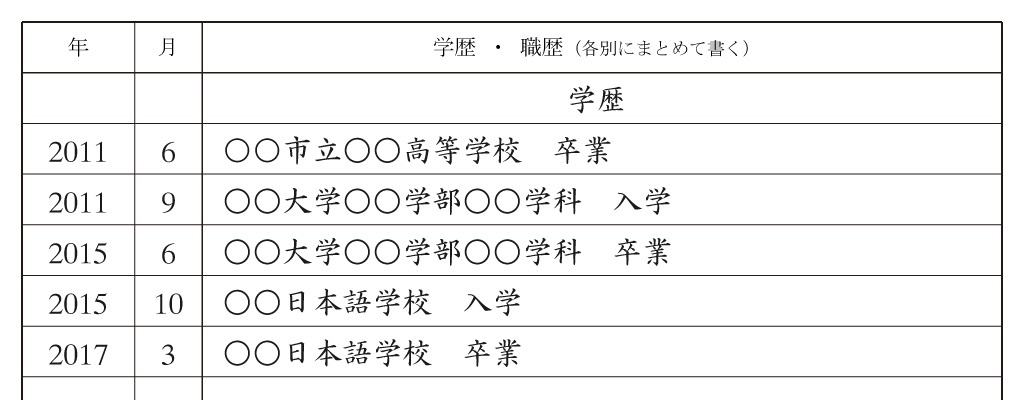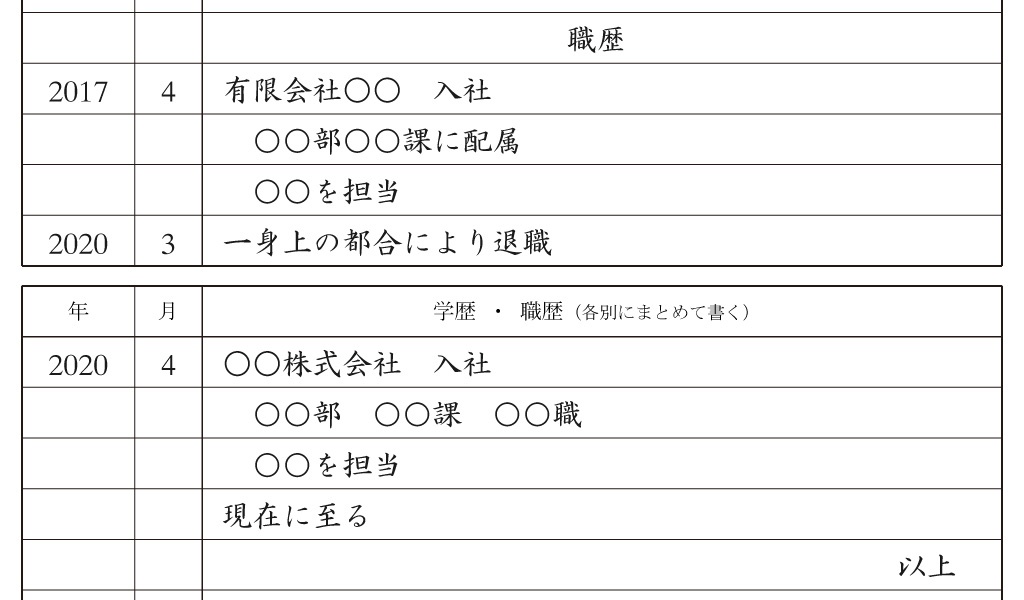How to Describe “Academic History/Work History” in your RIREKISHO – Documents required for job hunting 06

This post is also available in 日本語
In a “RIREKISHO”, which is required when you are hunting for a job in Japan, there is a section for describing your academic history/work history. This section is not only used for document screening, but also may be used and stored publicly as personnel data after entering the company. Be sure to fill out the “年 (Year)” and “月 (Month)” columns correctly. On this occasion, we shall introduce in detail how to fill out the “Academic History/Work History” sections of the RIREKISHO.
Related Articles on Documents Required for Job Hunting
- 01 What is a RIREKISHO and SHOKUMU KEIREKISHO?
- 02 Size of the RIREKISHO and SHOKUMU KEIREKISHO
- 03 Format types and Downloading templates(PDF/Word/Excel)
- 04 How to Write “Basic Information” in the RIREKISHO
- 05 “Photograph” to affix to the “RIREKISHO”
- 06 How to Describe “Academic History/Work History” in your RIREKISHO
- 07 How to Describe “License/Qualifications” in your RIREKISHO
- 08 How to Describe “Reason for Application” in your RIREKISHO
- 09 How to Describe “Personal Requests” in your RIREKISHO
Contents
Basic Entry Method

In the case of a general RIREKISHO format, these columns are at the bottom of page 1 (in case of a double-page spread, on the left side) and at the top of page 2 (in case of a double-page spread, on the right side). Start by filling out from page 1, and if you run out of space, you can also use the column on page 2. It is not a problem if you finish filling this out on page 1 and do not use the academic history/work history column on page 2.
Fill out the academic history and work history separately
Separate the academic history and work history, and fill out both chronologically. For example, if you took employment after graduating from university and then later joined a language school, only fill out the academic history in that section even though there was a period of employment in between.
After first entering your academic history, leave one line space, and then start entering your work history.
Enter the “Year” in the first column, the “Month” in the second column, and then the “Content” in the third column. You can use either the Western or Japanese calendar system. Be sure to use consistent notation for other items on “RIREKISHO (resume)” and “SHOKUMU KEIREKISHO (curriculum vitae)”.
After you complete the academic history and work history
After you finish entering all of your academic history and work history, enter “以上 (END)” justified to the right of the next line.
How to fill out academic history

Enter “学歴 (Academic history)” in the middle of the final column of the first line, and then enter your academic history from the next line.
From what stage of academic history should you include?
Basically, you should start entering from the one before your “final academic history”. Your “final academic history” is not the final educational establishment you graduated, but rather your highest level of education obtained.
- High school
- Language school
- Vocational school
- University
- Graduate school
For example, if you graduated high school -> university -> language school in that order, your final academic history would be university, so start entering from high school.
Enter using the official names
Use the official names of the educational establishment, and enter division, department, and major course. For example, even if the establishment is normally called “○○日本語学校”, if its official name is “〇〇法人〇〇日本語学校”, then use this name. If it is a school name from your home country where the reading is difficult, you should include furigana to show the phonetic reading.
About “卒業 (Graduation)”
If you left the course midway, enter “中退 (dropped out)”, and if you are currently studying, enter “卒業見込み (expect to graduation)”. In the case of graduation school, enter “修了 (Completed)” rather than “卒業 (Graduated)”.
How to fill out the work history

Enter “職歴 (Work history)” in the middle of the final column of the first line, and then enter your academic history from the next line.
What should you enter?
Enter the following items chronologically:
- Year/month entered, company name, and “入社 (Entered company)”
- Department name and position
- Basic description of work (can be omitted if not enough space)
- Year/month of leaving the company/reason for leaving
Normally, if you have changed jobs, you will submit your RIREKISHO and SHOKUMU KEIREKISHO at the same time. In the SHOKUMU KEIREKISHO, you will enter details about the job content, your experience, and skills, so you only need to enter general information here.
Enter using the official names
Enter the official name of the company. For example, rather than abbreviating as “(株)” enter ”株式会社”. In case you are working at a store, enter the company name rather than the store name.
Reason for leaving
You do not need to describe the detailed circumstances. In case you left after submitting a resignation request, simply enter “一身上の都合により退職 (resigned for personal reasons)”, whereas if you were dismissed by the company, enter “会社都合により退職 (left at the convenience of the company)”.
If you are still employed, enter “現在に至る (To present day)”.
Part-time jobs and internships
Basically, you should not include part-time jobs or internships. However, if you were in these positions for several months, and it is content that you can utilize in the employment for which you are applying, you can enter it as a point to provoke their interest. When entering such information, clearly state “アルバイト (part-time job)” or “インターン (internship)” after the company name.
In case of no work history

In case you do not have any work history, enter “なし (None)” justified to the left of the column.
Summary
On this occasion, we have introduced how to fill out the “Academic history/work history” section of a RIREKISHO. The RIREKISHO is a public document. The content is used not only for document screening, but also for procedures after entering the company or application for status of residence. Enter the “Year” and “Month” columns accurately. Next, we shall explain the “License/qualification” section of the RIREKISHO and the original items included in the RIREKISHO that can be downloaded from “Living in Japan”.
- Will You Get a Perfect Score? Test Your Knowledge of Japanese Dining Etiquette!
- Can You Answer All The Questions?[Résumé Quiz] – Reasons For Applying, and More (Part 2)
- How Many Can You Answer? [Résumé Quiz] – Pictures, Information, and More (Part 1)
- Don’t Make These Mistakes! 6 Important Business Manners at Work
- [Explained by a Legal Professional] Points to consider when you wish to work in Japan









